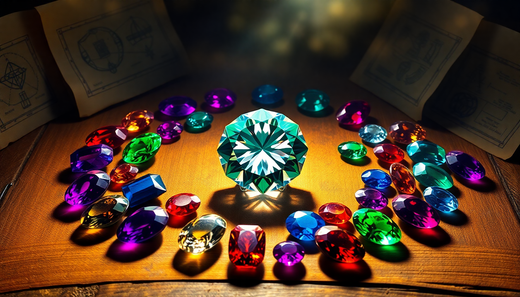
The Enchanting World of Gemstones: From Renaissance Beliefs to Modern Marvels
Share
In the captivating realm of gemstones, a tapestry of history, folklore, and belief systems intertwine, weaving a mesmerizing tale that has captivated humanity for centuries. From the grandeur of the Renaissance era to the present day, these natural wonders have held a special place in the hearts and minds of people across the globe.
The Renaissance and the Allure of Gemstones
The Renaissance, a period of unparalleled artistic and intellectual flourishing, was a time when gemstones were revered for their beauty, rarity, and perceived mystical properties. During this era, the wealthy and powerful adorned themselves with exquisite jewelry, each stone carefully selected to convey a specific meaning or attribute.
Sapphires, for instance, were believed to symbolize purity, wisdom, and loyalty, making them a popular choice for royal regalia and religious artifacts. Rubies, on the other hand, were thought to possess the power to ward off evil and promote good health, making them a highly sought-after gemstone for amulets and talismans.
The Symbolism of Gemstones
The Renaissance era was marked by a deep fascination with the symbolic meanings of gemstones, which were often rooted in ancient beliefs and traditions. Amethyst, for example, was believed to have the power to protect the wearer from intoxication and promote clear-mindedness, while emeralds were associated with fertility, rebirth, and the natural world.
This rich tapestry of gemstone symbolism was not limited to the upper echelons of society; it permeated all aspects of life, from the ornate jewelry of the nobility to the humble talismans carried by common folk. The belief in the inherent power of these natural wonders was a testament to the deep-rooted connection between humanity and the earth.
Gemstones in Folklore and Belief Systems
Across cultures and civilizations, gemstones have been imbued with a myriad of mythical and spiritual associations. In ancient Egypt, for instance, the scarab beetle was believed to be a symbol of rebirth, and the green-hued peridot was thought to possess the power to ward off nightmares and evil spirits.
Similarly, in the traditions of ancient India, the diamond was revered as a symbol of purity and invincibility, while the emerald was believed to possess the ability to grant the wearer clarity of vision and insight. These beliefs were not merely superstitions, but rather a reflection of the deep reverence and respect that people held for the natural world and its wondrous creations.
The Enduring Allure of Gemstones
Even in the modern era, the allure of gemstones continues to captivate and inspire. From the dazzling diamonds that adorn engagement rings to the vibrant hues of precious stones that grace the pages of high-fashion magazines, these natural marvels have maintained their status as symbols of beauty, wealth, and prestige.
Yet, beyond their aesthetic appeal, gemstones continue to hold a deeper significance, serving as reminders of the enduring connection between humanity and the natural world. Whether worn as a talisman, displayed as a work of art, or studied for their scientific properties, these captivating stones continue to captivate and inspire, inviting us to explore the rich tapestry of history, folklore, and belief that surrounds them.
The Enduring Allure of Gemstones
In the ever-evolving world of fashion and design, gemstones have remained a constant source of inspiration and fascination. From the dazzling diamonds that adorn engagement rings to the vibrant hues of precious stones that grace the pages of high-fashion magazines, these natural marvels have maintained their status as symbols of beauty, wealth, and prestige.
Yet, beyond their aesthetic appeal, gemstones continue to hold a deeper significance, serving as reminders of the enduring connection between humanity and the natural world. Whether worn as a talisman, displayed as a work of art, or studied for their scientific properties, these captivating stones continue to captivate and inspire, inviting us to explore the rich tapestry of history, folklore, and belief that surrounds them.
The Science of Gemstones
While the mystical and symbolic associations of gemstones have captivated the human imagination for centuries, the scientific study of these natural wonders has also yielded fascinating insights. From the intricate crystalline structures that give each stone its unique properties to the complex geological processes that formed them, the world of gemstone science is a testament to the incredible complexity and beauty of the natural world.
Through the lens of science, we can gain a deeper understanding of the unique characteristics and qualities of different gemstones, from the brilliant fire of a diamond to the soothing hues of an amethyst. This knowledge not only enhances our appreciation for these natural marvels but also informs the ways in which we use and appreciate them in our daily lives.
Conclusion
The enchanting world of gemstones is a tapestry of history, folklore, and belief that has captivated humanity for centuries. From the grandeur of the Renaissance era to the present day, these natural wonders have held a special place in the hearts and minds of people across the globe, serving as symbols of beauty, wealth, and the enduring connection between humanity and the natural world.
Whether adorning the finest jewelry, gracing the pages of high-fashion magazines, or inspiring the creation of amulets and talismans, gemstones continue to captivate and inspire, inviting us to explore the rich and fascinating history that surrounds them. As we delve deeper into the scientific understanding of these natural marvels, we are reminded of the incredible complexity and beauty of the world around us, and the enduring power of these captivating stones to capture our imagination and stir our souls.